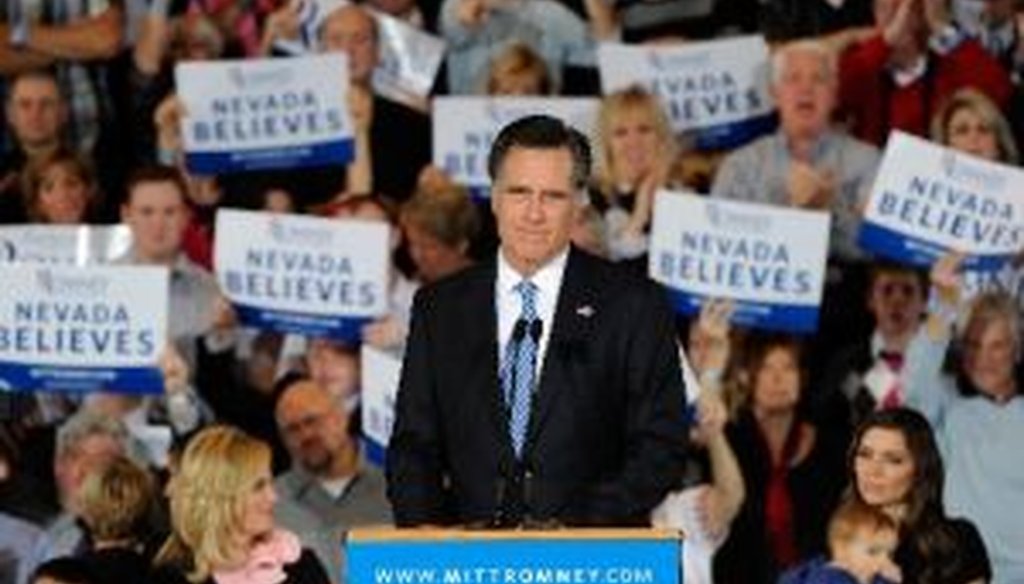



Mitt Romney speaks at the Red Rock Casino in Las Vegas, Nev., on Feb. 4, 2012, the day of the Nevada caucuses, which he won. We took a close look at this speech as a way of analyzing some of the themes he often articulates.
The last time we rated a Mitt Romney claim on unemployment, we dinged him with a Half True for using a big number without describing it accurately. This time, he got it right.
In a speech after winning the Nevada caucuses on Feb. 4, 2012, Romney said, "If you take into account all the people who are struggling for work or have just stopped looking, the real unemployment rate is over 15 percent."
That's much more accurate than his statement at the Tampa debate on Jan. 23, when he said that "we have 25 million Americans out of work." We rated that Half True, concluding that Romney had used a valid number but had described it incorrectly.
Here’s the background.
Every month, the federal Bureau of Labor Statistics surveys a cross-section of Americans to determine, among other things, their employment status. The respondents are characterized as either being in the labor force or out of it.
Those who are out of the labor force are not considered as seeking work at present. Some have no intention of working anytime soon -- they may be full-time students, stay-at-home parents, retired or physically unable to work. But others in this category are considered "marginally attached" to the labor force. They want work, are available to work and have looked for a job sometime in the prior 12 months -- but by the BLS definition, they do not qualify as being in the labor force because they have not actively searched for work in the previous four weeks.
Now let’s look at those considered to be in the labor force. They are categorized as either employed or unemployed. The "employed" group also has a sub-category -- part-timers who would rather be working full-time but who aren’t due to economic conditions.
For the best-known unemployment rate figure, the BLS divides the total number of the unemployed (that is, those without jobs who are actively looking for work) by the number of people in the labor force (that is, unemployed workers plus employed workers, both full- and part-time).
However, some critics have argued that this definition of unemployment is too limiting. So BLS also offers a broader, alternative measure of "labor underutilization" known as "U-6." It calculates this by dividing the sum of three groups (unemployed, marginally attached to the labor force and working part time for economic reasons) by the sum of the labor force plus marginally attached workers.
To make this methodology more concrete, let’s compare how those numbers looked in January 2012, the most recent month available.
The regular unemployment rate was 8.3 percent. However, the U-6 rate was significantly higher -- 15.1 percent. The difference stems from the fact that many workers are employed part-time when they’d rather be full-time or have given up looking work, at least for now. (Here's a comparison of various BLS measures.)
So Romney is right when he says that "if you take into account all the people who are struggling for work or have just stopped looking, the real unemployment rate is over 15 percent." This is an improvement from his phrasing in the Tampa debate, when he didn’t preface his statistic by noting that he’s referring to the broader, U-6 methodology.
A final bit of context: While it’s certainly bad news to have 15.1 percent of the workforce either unemployed or under-employed, it’s worth noting that this statistic, like the more commonly used unemployment rate, is heading in a favorable direction. After rising as high as 17.2 percent in October 2009, the U-6 is now as low as it’s been since February 2009, the second month of Barack Obama’s presidency.
That said, this level is still historically high. Since the statistic was first published in 1994, it has only broken into double digits for stretches following two previous recessions -- the recessions that hit in 1990-91 and 2001. And the U-6 peaks for those recessions were 11.8 percent and 10.4 percent, respectively -- well below even today’s improved level.
Our ruling
While the U-6 measurement is not the official gauge of unemployment in the United States, it’s a valid statistic to consider in conjunction with others. It's true that BLS describes it as a "labor underutilization" rate rather than an "unemployment" rate, since some of the people it counts are part-time workers who aren't officially "unemployed."
While this distinction is important to PhD economists, we don't think it's a major problem for a speech made to the general public. In other words, for a general audience, we think "the real unemployment rate" is acceptable shorthand for "the labor underutilization rate," especially when a brief description of the measure is provided. So we rate this claim True.
Mitt Romney, transcript of victory speech after Nevada caucuses, Feb. 4, 2012
Bureau of Labor Statistics, "Labor Force Statistics from the Current Population Survey," accessed Jan. 23, 2012
PolitiFact, "Mitt Romney says there are ‘25 million Americans out of work,’ " Jan. 23, 2012
National Bureau of Economic Research, "US Business Cycle Expansions and Contractions," accessed Feb. 8, 2012
Email interview with Gary Burtless, senior fellow at the Brookings Institution, Feb. 8, 2012
In a world of wild talk and fake news, help us stand up for the facts.
